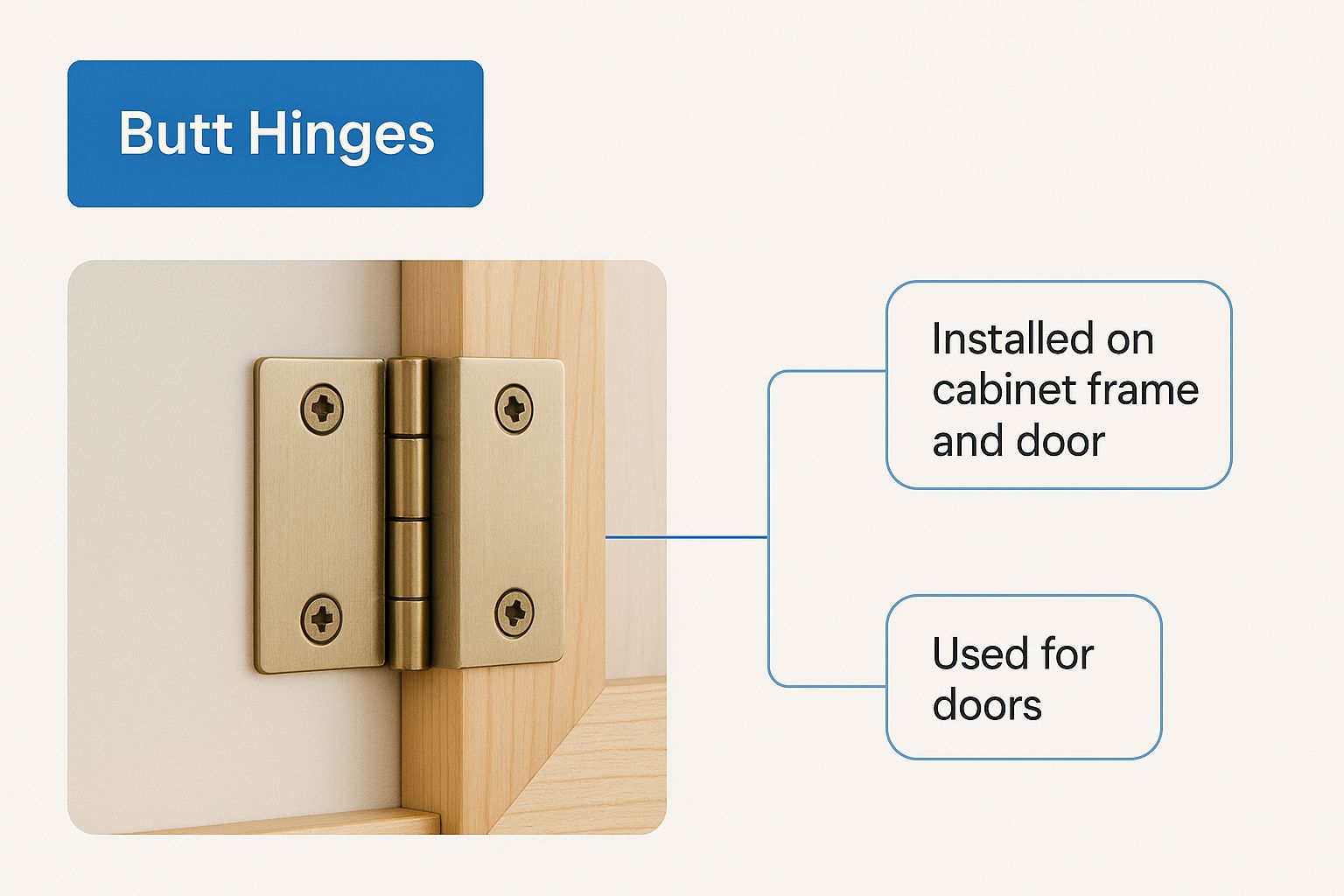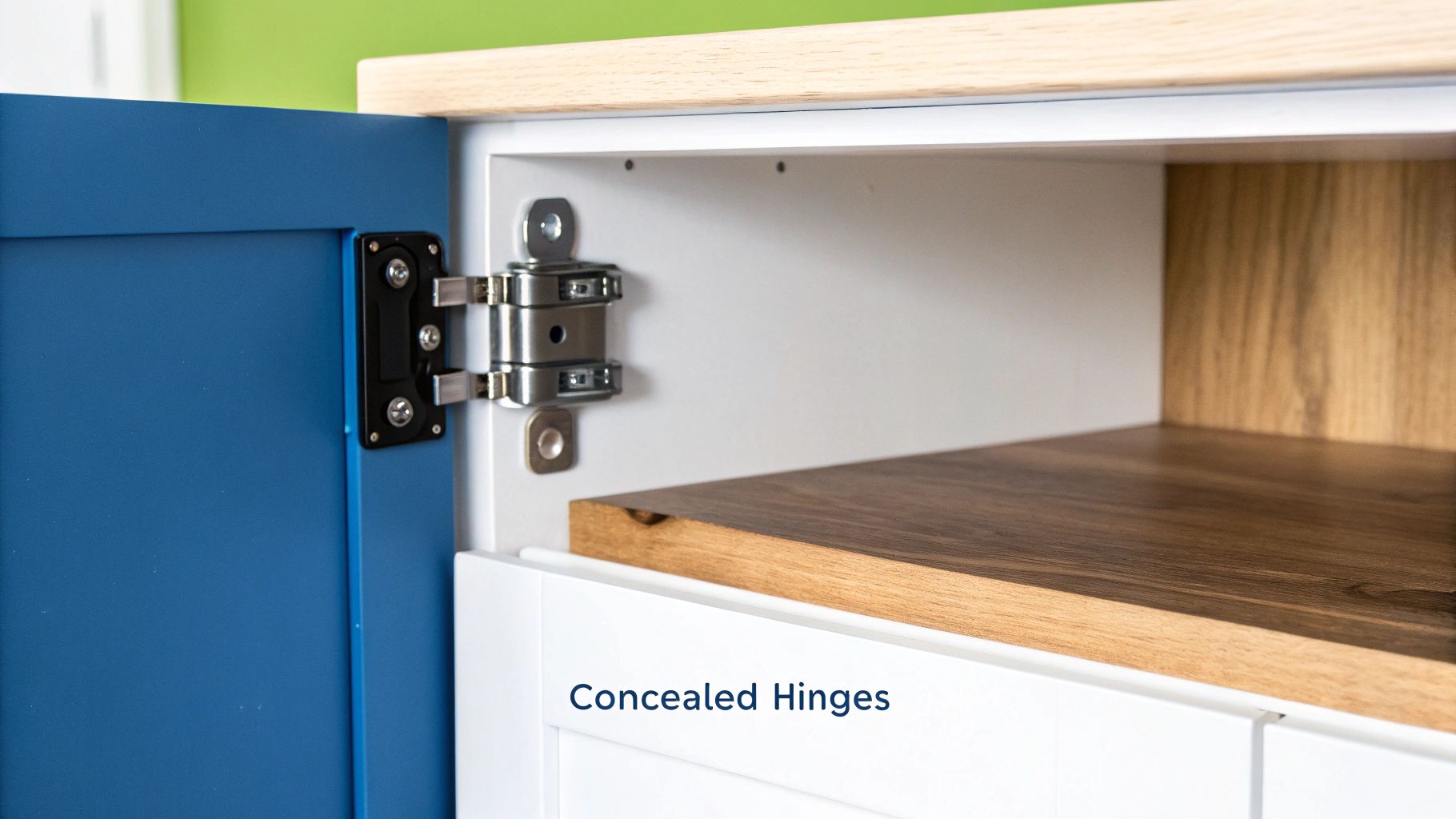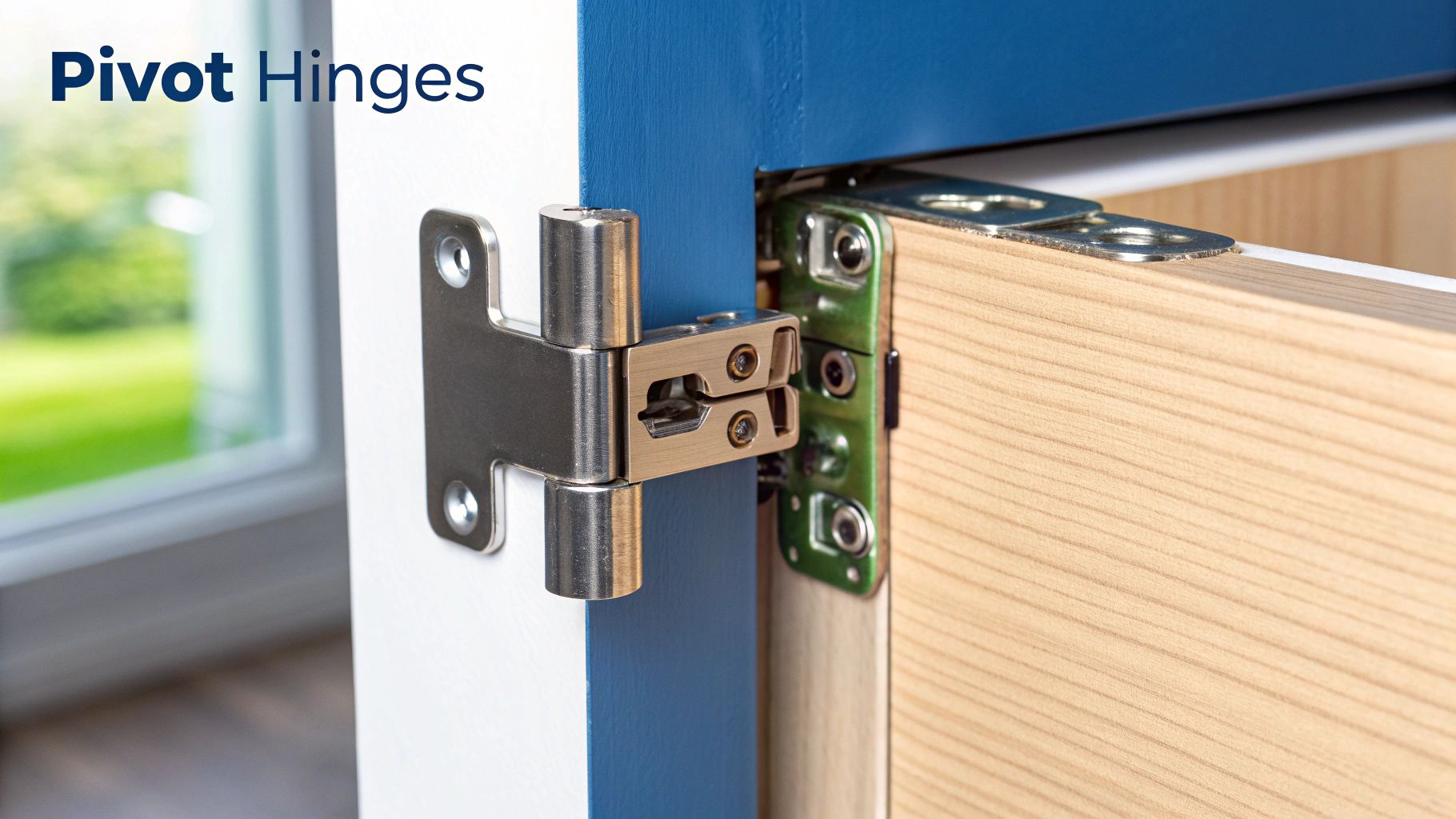- Straight to your door!
Straight to your door

Choosing the right hinge for your cabinets is about more than just making the door swing. It’s about getting that professional, polished finish where everything aligns perfectly and just feels right. Think of it as the unseen skeleton of your cabinet design – get this part right, and the rest of your project will fall into place beautifully.
The two most important concepts you need to get your head around from the start are ‘overlay’ and ‘inset’. This one detail dictates everything else.
Understanding this difference is everything. An inset hinge simply won’t work on an overlay door, and trying to use an overlay hinge for an inset cabinet will end in frustration. Knowing which you have prevents you from buying a pile of useless hardware. It's the first and most critical decision you'll make.
Here in the UK, there's been a real shift towards hardware that doesn't just work well but looks fantastic too. Concealed hinges absolutely dominate modern, high-end cabinetry for their clean, invisible finish. At the same time, traditional butt hinges are still a firm favourite for classic styles and projects where cost is a key factor.
This focus on both looks and longevity is reflected across the hardware market. For example, stainless steel has become a major player in the wider door hinge market, prized for its strength and ability to stand up to the damp and varied UK climate. If you're keen to understand the bigger picture, it's always useful to learn how to choose the correct door hardware to create a consistent look throughout a property.
And remember, this principle of smooth, quality movement isn’t just about hinges. To get that truly premium feel, you need to think about all the moving parts. Pairing your perfectly hung doors with high-quality mechanisms like these Hettich Quadro 4D soft-close drawer runners ensures every part of your project feels solid and well-built.
This guide will be your map, helping you navigate the options and select the right cabinet door hinge types for a flawless result.
Before you can even think about choosing a hinge, you need to get your head around one fundamental concept: how your cabinet door sits in relation to its frame. Get this wrong, and you're in for a world of headaches.
Think of it this way. An inset door is like a classic painting, sitting perfectly flush inside its frame. It creates a very traditional, seamless look often found in bespoke joinery. On the other hand, an overlay door is more like a poster stuck on a wall – it sits on top of the cabinet frame, covering it for a more modern, continuous appearance. Nailing this distinction is the first and most critical step to a professional-looking installation.
This image shows a close-up of a cabinet with traditional butt hinges, a common style you’ll see on inset doors.

As you can see, the hinge barrel is visible, making it a decorative feature in its own right. This is typical for many non-concealed hinges. Now, let’s dig a bit deeper into the overlay styles you'll come across.
When it comes to overlay doors, you’ll generally encounter two main types:
It’s vital to measure your specific overlay accurately to ensure the doors operate smoothly. For a partial overlay, you'll need to measure how much the door overlaps the cabinet opening. For a full overlay, this measurement is crucial for making sure the doors don't bash into each other when opened. This figure, usually given in millimetres, is what you'll use to select the right hinge.

Often called European hinges, these are the gold standard for today’s kitchens and furniture. Their biggest draw is elegantly simple: when the cabinet door is shut, you can't see them at all. This creates the sleek, uninterrupted surface that is so central to modern design.
That clean look is a major reason for their popularity, but their engineering is just as impressive. A concealed hinge is a two-part system. There's a hinge cup, which sits neatly inside a hole drilled into the door, and a mounting plate that fastens to the cabinet wall. This clever design is what gives them their signature 3-way adjustability, letting you fine-tune the door's final position with incredible precision.
Just like with traditional hinges, you can't just pick any concealed hinge off the shelf. You need to match it to your cabinet’s construction and how the door is mounted. The three main types you'll come across are:
Beyond these core types, modern hinges often bring a touch of luxury. Features like soft-close mechanisms, which stop doors from slamming shut, are now incredibly common. For a true minimalist aesthetic, push-to-open systems make completely handleless doors possible. These advancements reflect a real shift in the market, with modern hinges becoming the go-to for premium installations. You can find a great selection of hinges for thicker cabinet doors that pack in these advanced features.
The cabinet hinge market is growing steadily across the globe, with soft-close and self-closing hinges grabbing a significant share. Here in the UK, it's estimated these advanced hinges now make up 20-30% of all new installations in high-end cabinetry.

While concealed hinges give you that sleek, modern finish, sometimes a project calls for a bit more character. That’s where traditional and decorative hinges come in. These aren't meant to be hidden away; they're designed to be seen, becoming a key part of the furniture’s charm.
For centuries, the humble butt hinge has been the workhorse of cabinetry. It’s essentially two plates joined by a pin—simple, strong, and incredibly reliable. This makes it a perfect match for period properties, classic farmhouse kitchens, or any design where you want an authentic, time-honoured feel.
But moving beyond the purely functional opens up a world of decorative flair. These hinges are chosen for their style just as much as their strength, adding a unique touch that can define the entire look of your cabinets.
When you want your hardware to do some of the talking, several decorative styles really stand out. Each brings a different feel to the table, suited to various furniture designs.
The biggest trade-off with most traditional hinges is adjustability. Unlike their modern cousins, they offer very little wiggle room for tweaks after installation, so getting the fit right from the start is absolutely crucial.
Choosing between modern concealed hinges and traditional styles often boils down to your overall design vision. But what if you want the best of both worlds? While many traditional hinges are built for overlay doors, you can still get that classic inset look with all the perks of modern hardware. For example, a Blum clip-on inset hinge gives you the flush, clean finish of traditional joinery but with the advanced functionality and easy adjustment of today's technology.
Deciding between sleek, modern concealed hinges and their more visible traditional counterparts can be tricky. Both have their place, but they offer very different benefits and come with their own set of considerations. The table below breaks down the key differences to help you choose the right fit for your project.
| Feature | Concealed Hinges | Traditional Hinges |
|---|---|---|
| Aesthetics | Invisible when the door is closed, creating a seamless, modern look. | Visible and part of the design, adding character and a classic feel. |
| Adjustability | Highly adjustable in three directions (up/down, in/out, left/right). | Limited to no adjustment after installation. Precision is key. |
| Functionality | Often includes features like soft-close and various opening angles. | Basic open-and-close function. Some types allow wider opening. |
| Installation | Requires precise drilling (usually a 35mm cup hole) into the door. | Simpler surface mounting or requires cutting a recess (mortise). |
| Best For | Modern, minimalist, and handle-less kitchen and furniture designs. | Period properties, rustic, farmhouse, and traditional-style furniture. |
Ultimately, there's no single "best" option. Concealed hinges are unbeatable for a clean, contemporary look and offer unmatched adjustability. However, if you're aiming for a design with more personality or historical authenticity, a well-chosen traditional hinge can become a beautiful decorative feature in its own right.
Not every cabinet fits neatly into a standard layout. What do you do when you’re faced with an awkward corner, a heavy lift-up door, or a delicate glass display? This is where speciality hinges step in, offering clever solutions for those unconventional designs where standard hardware just won’t cut it. Think of them as the problem-solvers of the hardware world, engineered for specific, often tricky, situations.
Take those deep, hard-to-reach corner cupboards, for instance. They can be a real headache, but with bi-fold or pie-cut hinges, they become fully accessible. These allow two joined doors to fold together smoothly, opening up the entire corner space. Or what about a long, heavy lid on a toy box or window seat? A piano hinge provides continuous support along the entire length, preventing the wood from warping and keeping everything stable.
Beyond just tricky corners, speciality hinges are brilliant for achieving unique aesthetics or working with unusual materials. If you’re aiming for that minimalist, ‘floating’ door effect, pivot hinges are your best friend. They mount at the top and bottom of the door, making the hinge mechanism almost invisible.
When you're working with fragile materials like glass or acrylic, you can't just screw in a standard hinge. Special glass door hinges are designed to clamp onto the material without any drilling, which prevents cracks and damage while still providing a secure fixing point.
Another common problem that needs a specialist solution is cabinet safety, especially in homes with young children. It’s not just about picking the right hinge for the door to swing correctly; it’s also about keeping little hands out. Learning how to effectively baby-proof your cabinets is a vital step, where specialist locks and latches work alongside your hinges to create a safe home.
Ultimately, knowing about these different cabinet door hinge types gives you the confidence to tackle any design challenge. It ensures every door in your project functions perfectly, no matter how unusual its placement or material might be.
While the mechanism is key, a hinge's material is just as crucial. It’s what dictates its lifespan and look, especially in moisture-heavy zones like kitchens and bathrooms. The wrong material here can lead to rust and a hinge that gives up long before its time.
For most modern cabinets, stainless steel is the go-to material. It’s tough, long-lasting, and its natural resistance to corrosion makes it a reliable workhorse for any room in the house. It's no surprise that stainless steel is set for steady market growth, as it's a favourite for new builds and renovations alike. You can discover further insights into the UK hardware market to see just how popular it is.
If you’re aiming for a more traditional feel, brass hinges offer a classic warmth that steel can’t quite match. Though not as tough against corrosion, they're perfect for bringing a vintage charm to period-style furniture.
Beyond the raw material, the finish is what pulls your hardware together with the rest of your design. Get this right, and you create a polished, intentional look that feels complete.
Your hinge finish doesn't have to be an exact match to your handles or taps, but it should feel like it belongs in the same family. A cohesive design is about coordination, not perfect replication.
Some of the most popular finishes you'll come across include:
Even after getting to grips with the different hinge types, a few questions always seem to pop up during a project. Don't worry, it's completely normal. Let's walk through some of the most common queries we hear from DIYers and professionals alike.
This is a great question, and the answer is usually right in front of you. Take a look at how your cabinet door sits against the cabinet frame. If the door sits entirely inside the frame, so its front face is perfectly level with the frame itself, you're looking at an inset hinge job.
On the other hand, if the door rests on top of the frame, covering it partly or completely, you have an overlay door. For this, you'll need overlay hinges. Just measure how much the door overlaps the frame to find the exact overlay size you need.
Absolutely. Swapping out old, visible hinges for modern concealed ones is a fantastic way to give a kitchen a clean, updated look. It does require a bit of extra work, though.
You'll need to drill a large, circular recess into the back of the door to house the hinge's cup – this is typically a 35mm hole. The screw holes left by the old hinges on both the door and the frame will also need to be filled and touched up to get that seamless, professional finish.
A soft-close hinge uses a built-in damper to stop a door from slamming. It gently catches the door in the final few centimetres of its travel and closes it quietly. For the quieter home and reduced wear on frames, most people agree it's well worth the small extra cost.
This one often catches people out, but it's simple once you know what to look for. A face-frame cabinet has a solid wood frame fixed to the front of the main cabinet box, and this is what your hinges mount to. Think of it as a picture frame for your cabinet opening.
In contrast, a frameless cabinet, which is very common in European kitchen designs, is essentially just a simple box. The hinges mount directly onto the internal side walls of the cabinet. Because of this difference, they require completely different mounting plates.
Whether you're doing a simple cupboard refresh or a full-scale kitchen installation, having the right hardware is what makes the difference. Neasden Hardware offers an extensive range of high-quality cabinet hinges and ironmongery to ensure you get a professional result, every single time.
Browse our full collection of cabinet hardware at neasdenhardware.co.uk